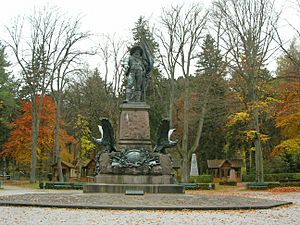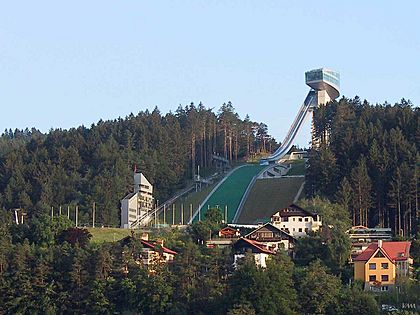Battles of Bergisel facts for kids
Quick facts for kids Battles of Bergisel |
|||||||
|---|---|---|---|---|---|---|---|
| Part of the Tyrolean Rebellion | |||||||
 Statue of Andreas Hofer near Bergisel in Innsbruck |
|||||||
|
|||||||
| Belligerents | |||||||
| Commanders and leaders | |||||||
| Strength | |||||||
| 5,000 | 5,000 (later 15,000) | ||||||
The Battles of Bergisel were four important fights. They happened between local people from Tyrol and soldiers from Austria. They fought against the armies of Emperor Napoleon I of France and the King of Kingdom of Bavaria. These battles took place on the Bergisel hill, which is near Innsbruck.
The battles happened on May 25, May 29, August 13, and November 1, 1809. They were part of the Tyrolean Rebellion and a bigger conflict called the War of the Fifth Coalition. The Tyrolean fighters were loyal to Austria. They were led by brave commanders like Andreas Hofer, Josef Speckbacher, Peter Mayr, and Father Joachim Haspinger. The Bavarian forces were led by French Marshal François Joseph Lefebvre and Bavarian Generals Bernhard Erasmus von Deroy and Karl Philipp von Wrede.
The Tyroleans were able to push the Bavarians out of Innsbruck twice. But after the last battle in November, the rebellion was finally put down.
Contents
Why the Battles Happened
After a big defeat in the War of the Third Coalition, Napoleon gave the region of Tyrol to Bavaria. The new Bavarian rulers started making changes that the Tyroleans didn't like. For example, they made people join the army, even if they didn't want to. They also tried to make new laws that went against Tyrol's old traditions and religious beliefs. One of these was a required vaccination program for smallpox, which many Tyroleans saw as wrong for their faith.
Before the War of the Fifth Coalition started, Austrian agents secretly encouraged the Tyroleans to rebel. So, when Austrian forces invaded Bavaria in April 1809, the Tyrolean people decided it was time to fight back.
The Fights at Bergisel
First Battle: April 1809
On April 11, Andreas Hofer and about 5,000 armed farmers won an early victory. They captured 420 Bavarian soldiers in South Tyrol.
The Tyroleans, led by Martin Teimer, had a great start. They attacked the Bavarian soldiers in Innsbruck for 48 hours straight. The Bavarian commander, Baron Kinkel, had to surrender his 3,860 soldiers on April 13. Then, 2,050 French soldiers, who didn't know what was happening, marched right into the trap. They also surrendered. The rebels took five cannons, two mortars, and many muskets. These weapons helped the Tyroleans fight for months.
May 1809 Events
Soon, Austrian soldiers joined the Tyroleans. This made them a threat to Napoleon's armies in Italy and Bavaria. One group of Tyrolean fighters even raided an area near Lake Garda in Italy. This forced the French leader in Italy to send many soldiers to guard the area.
In early May, Napoleon sent Marshal François Joseph Lefebvre and his Bavarian soldiers to Tyrol. Lefebvre defeated the Austrian commander at the Battle of Wörgl on May 13. After more fighting, Lefebvre took over Innsbruck around May 19.
Second Battle: May 29, 1809
On May 25, 1809, Bavarian soldiers fought the Tyrolean rebels at Bergisel. The Bavarians had 4,000 troops and 12 cannons. Hofer led the rebel army, which had 9,400 armed rebels and 900 Austrian soldiers. The fighting was tough, and both sides lost men. The Tyroleans then retreated south.
The Tyroleans came back on May 29 for a second attack. This time, they had 13,600 irregular fighters and 1,200 Austrian soldiers with six cannons. The Bavarians managed to hold their ground. But the next day, they were low on supplies. So, they left Innsbruck and went back to Kufstein Fortress in the north.
July and Early August 1809
After Napoleon won a big victory at the Battle of Wagram in July, Lefebvre invaded Tyrol again. But the Tyroleans answered Hofer's call for another uprising. About 5,000 Tyroleans, led by Haspinger and Speckbacher, defeated 3,600 German soldiers at Franzensfeste on August 4 and 5. This area is still known as the Sachsenklemme (Saxon Trap).
The next day, Lefebvre arrived with more Bavarian soldiers, but the Tyroleans pushed them back too. On August 8 and 9, Tyrolean fighters defeated 2,000 Bavarian soldiers at Prutz. The Tyroleans captured many men and two cannons, while losing very few of their own.
Third Battle: August 13, 1809
On August 13, Hofer and 18,000 Tyroleans fought the Bavarians in the third battle of Bergisel. The Bavarians lost many soldiers. After this, Lefebvre took important local people as hostages. He then left Innsbruck, and by August 18, all the occupation troops were gone from Tyrol.
September and October 1809
On September 25, Speckbacher and 2,000 Tyrolean fighters attacked Bavarian soldiers in several villages. They captured many soldiers and scattered the rest. On the same day, Haspinger and his Tyroleans pushed a Bavarian brigade out of the Lueg Pass. The Bavarians retreated north to Salzburg.
Later, a new French commander, Jean-Baptiste Drouet, Comte d'Erlon, took over. He launched the third invasion of Tyrol. On October 17, Bavarian soldiers surprised Speckbacher and his 2,000 men. The Tyroleans were caught off guard and suffered a serious defeat. They lost many men, and the Bavarians had very few casualties.
Fourth Battle: November 1, 1809
The fourth and final battle of Bergisel happened on November 1, 1809. Bavarian soldiers defeated Hofer's and Haspinger's Tyrolean fighters. The Bavarians had 6,000 troops and 12 cannons. They lost very few men. The Tyroleans suffered many casualties and lost five cannons. This last battle and the earlier defeat broke the spirit of the rebellion.
Sadly, Andreas Hofer was betrayed to the French on January 28, 1810. He was captured and, on Napoleon's orders, was put to death on February 20, 1810, in Italy.




